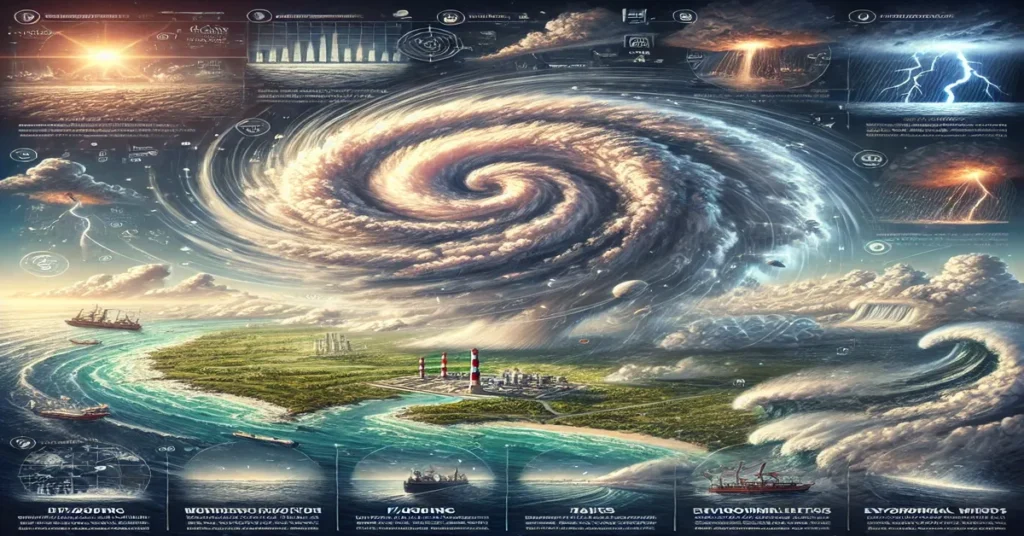Cyclones, known as “ciclon” in Spanish, are powerful weather systems that have a significant impact on the regions they affect. These storms, which can vary in size and intensity, often bring heavy rainfall, strong winds, and, in severe cases, massive destruction to coastal and inland areas. Cyclones are a natural phenomenon but are influenced by climatic changes and atmospheric conditions, making them an essential subject for meteorologists, environmental scientists, and communities vulnerable to their effects.
In this comprehensive guide, we’ll delve into the science behind cyclones, the different types of cyclones, their causes and effects, and how humans can prepare for and mitigate their impacts. By the end, you’ll have a thorough understanding of what cyclones are, how they form, and why they’re essential to study in the context of climate change and environmental science.
What is a Cyclone?
A cyclone is a large-scale air mass that rotates around a strong center of low atmospheric pressure. In simple terms, it’s a system of winds rotating inward to an area of low pressure. Cyclones are characterized by heavy rain, high winds, and, depending on their location, they may also bring thunderstorms and storm surges.
Cyclones are categorized based on their intensity, location, and origin. While they are often associated with destructive weather, cyclones also play a role in the Earth’s atmospheric balance, distributing heat and moisture from the tropics to other regions. This process is vital for maintaining global temperature and weather patterns.
Cyclones occur in different forms around the world, each with distinct characteristics. In some areas, they are referred to by different names, such as hurricanes in the North Atlantic and typhoons in the Northwest Pacific.
Types of Cyclones
There are several types of cyclones, each with unique characteristics. Here are the main types:
1. Tropical Cyclones
Tropical cyclones form over warm tropical waters, where the sea surface temperature is at least 26.5 degrees Celsius. These cyclones are powered by the heat and moisture of the ocean and can develop into powerful storms with sustained winds of over 119 kilometers per hour. Tropical cyclones are classified into three categories based on their intensity:
- Tropical Depression: The weakest form of a tropical cyclone, with wind speeds below 63 km/h.
- Tropical Storm: Wind speeds between 63 km/h and 119 km/h.
- Hurricane/Typhoon: When wind speeds exceed 119 km/h, the tropical storm becomes a hurricane or typhoon, depending on its location.
Tropical cyclones are known for their destructive potential, as they can bring storm surges, heavy rain, and strong winds that cause flooding, property damage, and loss of life.
2. Extratropical Cyclones
Extratropical cyclones form in mid-latitude regions, typically between 30 and 60 degrees latitude. Unlike tropical cyclones, they do not rely on warm water to form. Instead, they develop due to temperature contrasts between air masses and are driven by the jet stream. Extratropical cyclones are common in regions such as the North Atlantic and North Pacific and are responsible for much of the stormy weather experienced in those areas.
Extratropical cyclones can be as powerful as tropical cyclones, especially when they transition into “bomb cyclones” — storms that experience rapid intensification due to a sudden drop in atmospheric pressure.
3. Subtropical Cyclones
Subtropical cyclones are a hybrid between tropical and extratropical cyclones. They form over subtropical waters, generally between 25 and 40 degrees latitude, and exhibit characteristics of both tropical and extratropical cyclones. Subtropical cyclones typically have a broader wind field and weaker central core compared to tropical cyclones, making them less intense but still capable of causing significant weather disturbances.
4. Polar Cyclones
Polar cyclones, also known as polar lows, form in polar regions and are smaller, short-lived storms with strong winds and snow. These cyclones are most common in the winter months and can bring cold temperatures, snowfall, and blizzards to polar regions. Polar cyclones play a role in influencing Arctic and Antarctic climate patterns and contribute to cold-air outbreaks.
5. Mesocyclones
Mesocyclones are smaller-scale cyclones that form within severe thunderstorms. They are associated with rotating updrafts within thunderstorms and can lead to the formation of tornadoes. While mesocyclones are not classified as large-scale cyclones, they are essential in understanding severe storm formation and tornado outbreaks.
How Cyclones Form: The Science Behind Cyclogenesis
The process of cyclone formation is known as cyclogenesis. Cyclones form due to specific atmospheric and environmental conditions that allow a low-pressure center to develop and grow. Here are the steps involved in cyclogenesis:
- Warm, Moist Air: For tropical cyclones, the ocean’s surface temperature needs to be above 26.5 degrees Celsius. This warmth causes water to evaporate, creating humid air that rises into the atmosphere.
- Low-Pressure Center: As warm, moist air rises, it cools and condenses, releasing latent heat. This process creates a region of low pressure at the surface.
- Coriolis Effect: Due to Earth’s rotation, air moving toward the low-pressure center begins to spiral, creating a rotating system. This rotation is more pronounced near the poles and weaker at the equator.
- Development of an Eye: As the cyclone intensifies, a calm area, known as the eye, forms at its center. Surrounding the eye is the eye wall, which is the most intense part of the cyclone, with strong winds and heavy rain.
- Continued Energy from the Ocean: As long as the cyclone remains over warm water, it will continue to draw energy from the ocean. This process allows the cyclone to grow in size and intensity.
Once a tropical cyclone moves over land or colder water, it loses its source of energy and begins to weaken.
Impacts of Cyclones on the Environment and Society
Ciclon have profound impacts on the environment and society. Here’s a look at some of the key effects of these powerful weather systems:
1. Flooding
Cyclones often bring torrential rain, which can lead to widespread flooding. This flooding can cause severe property damage, disrupt transportation networks, and displace communities. Coastal areas are particularly vulnerable to flooding due to storm surges, which are caused by the strong winds pushing seawater inland.
2. Wind Damage
High winds are one of the defining features of cyclones, particularly in hurricanes and typhoons. These winds can cause structural damage to buildings, uproot trees, and create hazardous debris. In severe cases, entire communities can be destroyed by the wind alone.
3. Coastal Erosion
Storm surges and high waves can erode coastlines, leading to the loss of land and damage to natural habitats such as beaches and coral reefs. Coastal erosion can also compromise sea defenses, putting more areas at risk during future storms.
4. Economic Losses
The economic impact of cyclones can be significant. Damaged infrastructure, disrupted businesses, and costly relief efforts add up to substantial financial losses. Cyclones can also affect agricultural production, leading to crop losses and increased food prices.
5. Impact on Ecosystems
Cyclones can have both positive and negative impacts on ecosystems. While they can cause destruction, cyclones also help distribute nutrients in the ocean and promote the mixing of different water layers. However, the destruction of coral reefs, wetlands, and forests by cyclones can have long-term consequences for biodiversity ciclon.
6. Loss of Life and Human Displacement
Cyclones can result in loss of life, particularly in regions with limited resources for disaster preparedness. Evacuations and infrastructure damage often lead to displacement, with communities losing their homes and livelihoods.
Preparing for Cyclones: Safety Measures and Mitigation
Preparing for cyclones is essential to minimize their impact. Governments, communities, and individuals all play a role in cyclone preparedness. Here are some key strategies:
- Early Warning Systems: Meteorological agencies monitor weather patterns and issue early warnings to help communities prepare for incoming cyclones. These warnings allow people to evacuate if necessary and prepare their homes.
- Building Resilience: In cyclone-prone regions, buildings and infrastructure can be designed to withstand high winds and flooding. Elevated structures, storm-proof windows, and flood barriers are some of the measures that can reduce ciclon damage.
- Community Education: Educating communities about cyclone risks and preparedness is crucial. Awareness programs teach people how to respond during a cyclone, which reduces panic and improves safety.
- Emergency Kits: Households should have emergency kits that include essentials such as water, non-perishable food, flashlights, first aid supplies, and important documents. These kits are vital in the event of a ciclon.
- Coastal Zone Management: Coastal zones can be managed to minimize the impact of cyclones. For instance, mangroves and wetlands act as natural buffers against storm surges, reducing flooding in coastal areas.
- Evacuation Plans: Having a clear evacuation plan is essential for communities in cyclone-prone areas. Authorities should designate evacuation routes and shelters for residents ciclon.
Climate Change and Cyclones
Climate change has a significant impact on cyclone patterns. As global temperatures rise, the frequency, intensity, and distribution of cyclones are changing. Here are some of the ways climate change affects cyclones:
- Increased Intensity: Warmer ocean temperatures provide more energy for cyclones, which can lead to more intense storms. Scientists have observed an increase in Category 4 and 5 cyclones in recent decades.
- Rising Sea Levels: Rising sea levels contribute to more severe storm surges, increasing the risk of coastal flooding during cyclones.
- Changing Frequency: While the total number of cyclones may not be increasing, some regions may experience more frequent storms, while others may see a decrease. This shift can affect ecosystems and human populations ciclon.
- Extended Cyclone Seasons: With warmer temperatures, the cyclone season is extending in some regions, increasing the likelihood of cyclones outside the traditional season.
- Impact on Vulnerable Communities: Climate change exacerbates the effects of cyclones on vulnerable communities, particularly in developing countries with limited resources for adaptation ciclon.
Conclusion
Ciclon are powerful natural phenomena that significantly impact the environment, economy, and human life. Understanding the science behind cyclones, their types, and their effects helps us appreciate the importance of preparedness and resilience in the face of these storms. With climate change influencing cyclone patterns, it is more important than ever to adopt sustainable practices and invest in disaster management strategies to protect vulnerable communities.
By recognizing the role of cyclones in global weather patterns and taking steps to mitigate their impact, we can reduce their destructive power and build a more resilient world ciclon
FAQs
1. What is the difference between a cyclone, hurricane, and typhoon?
Cyclones, hurricanes, and typhoons are all the same weather phenomenon. They are called different names depending on the region: hurricanes in the Atlantic, typhoons in the Northwest Pacific, and cyclones in other parts of the world.
2. How are cyclones named?
Cyclones are named by meteorological organizations to make communication easier. Each region has a pre-determined list of names that rotates over the years.
3. Can cyclones be prevented?
Cyclones are natural events driven by atmospheric and oceanic conditions, so they cannot be prevented. However, their impact can be minimized through preparedness and resilience measures.
4. How does climate change affect cyclones?
Climate change contributes to warmer oceans and rising sea levels, which can increase the intensity and frequency of cyclones, as well as the severity of storm surges.
5. What is the eye of a cyclone?
The eye is the calm center of a cyclone, surrounded by the eye wall, which contains the most intense winds and rainfall. Inside the eye, conditions are relatively calm.
6. Are cyclones dangerous only in coastal areas?
While coastal areas are most vulnerable due to storm surges and high winds, cyclones can also cause heavy rain and flooding inland, posing risks far from the coast.







